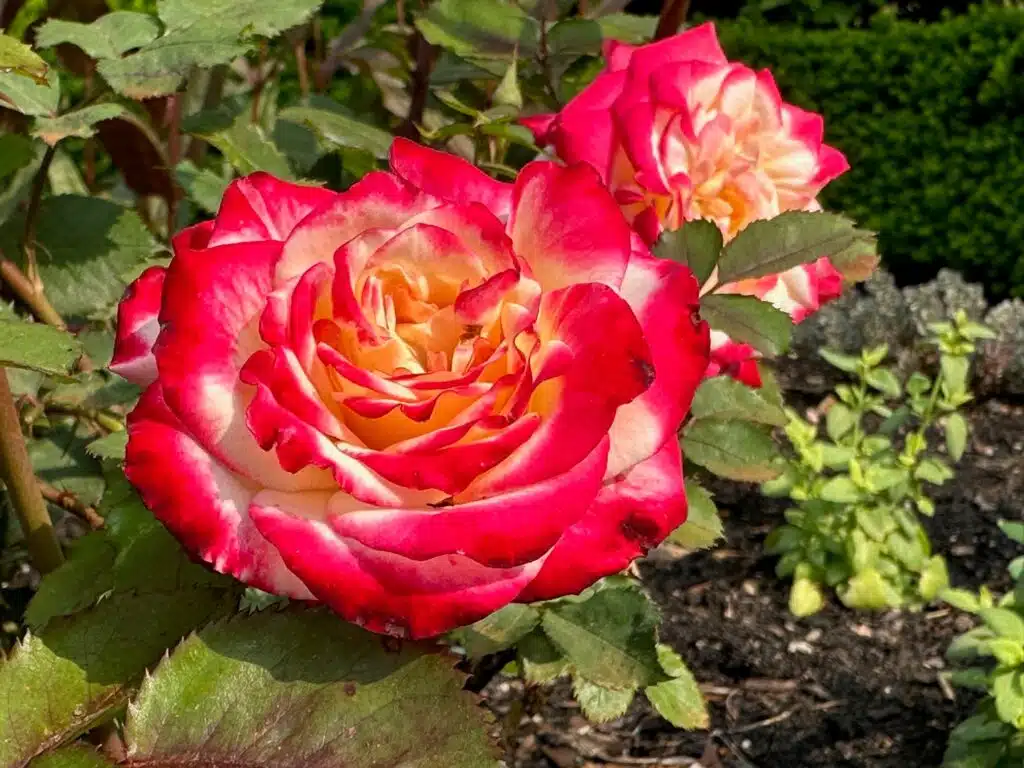
The trees are green, and shade is now dominant in our forests and woodland gardens. As summer grows near, our blooms will begin to pop in open areas- seek out the Rose Garden and Western Reserve Herb Society Garden for copious blooms and the display garden at the Arboretum. And this week, be sure to visit both campuses to see two wonderful shows – BLOOM! Botanicals & Birdhouses at the Cleveland Botanical Garden, and Sean Kenney’s Nature Connects made with LEGO Bricks at the Holden Arboretum.
Cleveland Botanical Garden
My first stop this week was the rose garden. Horticulturist Stefanie Verish installed an entirely new design last fall, and it’s starting to pop! I’ve been checking each week to see when the new group of floribunda roses, each a different color, start to bloom. I spotted the lovely White Lies™, whose petals first emerge as white and then quickly take on a brilliant scarlet color. Another is Sultry Sangria ™. This deep purplish magenta floribunda rose is simple yet intensely colored. Finally, there are many early blooming roses, including several rugosa hybrids, in the Western Reserve Herb Society’s historical rose garden. Pinks, reds, whites and yellows are plentiful. The roses are changing constantly in this garden – be sure to come back several times to not miss one of their many rare, historical roses.


Now blooming in the Woodland Garden is fringe-tree, named for its straplike petals on its flowers. Combined in a large panicle, the tree looks like it has white fringe fabric hanging from its branches. Another flowering tree that you’ll spot in the Children’s Garden is tuliptree, also known as tulip poplar and yellow poplar. The flowers are starting to fall to the ground from high above, and you can clearly see how this tree got its name.


Two other curious plants to be on the look out for: The European native Italian arum is growing along the stream in the woodland garden. This temperate aroid looks downright tropical, and i’s huge spathe and spadix flower almost looks out of place- it looks more like one of the tropical aroids that have become so popular as house plants today. Finally, in the Children’s Garden, look for the first blooms of Virginia spiderwort, a late spring bloomer.


Holden Arboretum
The rhododendrons are still superb. Walk to the southern area of the garden, including the Rhododendron Disovery Garden and the Layer Rhododendron Garden (near the Canopy Walk) to stroll through the beautiful blooms. But things are popping everywhere, and I’ll feature a few highlights captured by plant records curator Ethan Johnson.
Exit out the back doors of the Corning Visitor Center to meander through the Butterfly Garden and spot our first featured bloom this season, Baptisia ‘Carolina Moonlight’ and it’s pale yellow pea-like flowers. In the widlfower garden, spot the fertile fronds of Cinnamon fern– they look like huge sticks of cinnamon rising up from its base. In the Rhododendron discovery garden, find the stunning red peony “Paeonia ‘Coral Sunset’ and the lovely lavender and purple bearded iris. You’ll also find two rhodies that are looking spectacular, the white ‘Edmond Amateis’ and pink ‘Bali’. So much is blooming at the arboretum, everywhere you go, you’ll find spectacular blooms.




Hasn’t this spring been amazing? Hopefully you have had multiple chances to visit, but it’s not too late. The flowers keep coming, and there is something new to see every week!

Thomas Arbour
Curator of Living Collections
I grew up in northeast Ohio, graduating from Stow High School. I attended Hiram College, where I learned to love plants through the mentoring of Dr. Matt Hils. After Hiram, I obtained a Master of Environmental Science at Miami University, completing an internship with The ODNR Division of Natural Areas and Preserves in Columbus to help convert the Ohio Natural Heritage Database from paper maps to a GIS-based system. Over 20+ years, I worked with ODNR in central office in Columbus as a rare plant botanist, wildlife research technician, nature preserves administrator, and finally, the state trails administrator. In these positions, I had the opportunity to document many of Ohio's rarest plants and plant communities.













